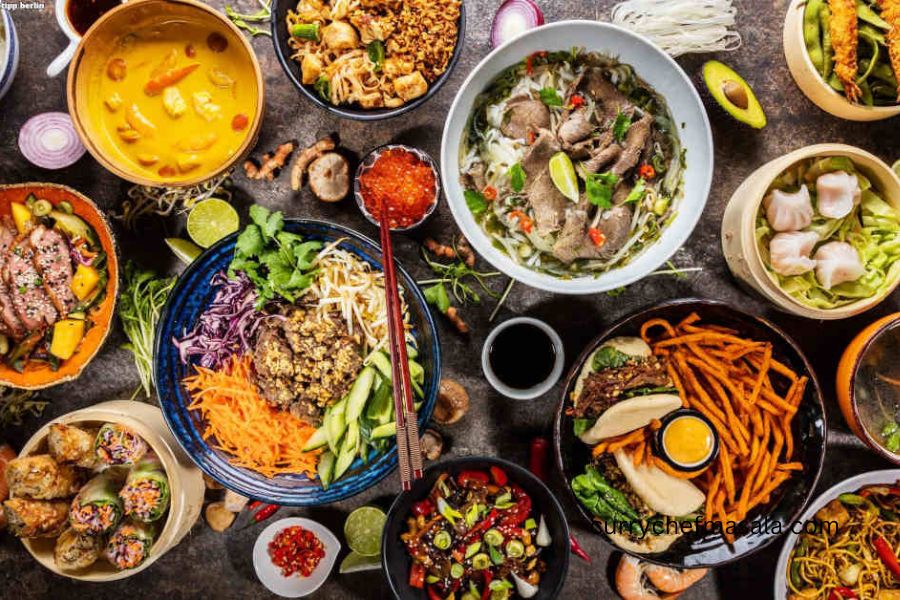Asian cuisine is known for its rich flavors, diverse spices, and fresh ingredients from various cultures in Southeast Asia, Europe, America, and beyond. With a wide range of dishes and cooking techniques, Asian cuisine offers a sensory experience that tantalizes taste buds with a combination of sweet, salty, and spicy flavors.
From sushi in Japan to pho in Vietnam, each Asian dish showcases the unique characteristics of the region it originates from. With its emphasis on vegetables and a variety of textures, Asian cuisine continues to captivate food lovers worldwide. Whether you’re a fan of dim sum, kimchi, or curry, there’s something for everyone to enjoy in the vibrant and flavorful world of Asian cuisine.
Introduction To Asian Cuisine
Asian cuisine is a vibrant and diverse culinary tradition that has captivated food enthusiasts all over the world. Whether you are a fan of Chinese stir-fries, Japanese sushi, Thai curries, or Indian biryani, Asian cuisine offers a wide array of flavors, textures, and aromas that are sure to satisfy even the most discerning palate.
Exploring The Flavors Of The East
Asian cuisine is known for its bold and distinct flavors that tantalize the taste buds. From the umami-rich dishes of Japan to the fiery spices of India, each country in Asia has its own unique culinary identity. Chinese cuisine, for example, is characterized by its delicate balance of sweet and savory flavors, while Thai cuisine is renowned for its harmonious blend of spicy, sour, sweet, and salty notes. Whether you prefer mild or intense flavors, Asian cuisine has something to offer for everyone.
Richness Of Vegetables And Spices
A key aspect of Asian cuisine is its emphasis on fresh vegetables and aromatic spices. Vegetables play a prominent role in Asian dishes, adding color, texture, and nutrients. From crunchy bok choy and tender broccoli to vibrant bell peppers and earthy mushrooms, Asian cuisine celebrates the natural flavors and textures of these plant-based ingredients. In addition, the region is rich in spices such as ginger, garlic, chili peppers, turmeric, and lemongrass, which infuse dishes with their unique aromas and tastes.
Combination Of Salty, Sweet, And Spicy Flavors
One of the distinguishing features of Asian cuisine is its skillful balance of salty, sweet, and spicy flavors. This harmonious combination creates a multi-layered taste experience that is both satisfying and addictive. Take, for example, the popular Korean dish, bulgogi, which features tender and savory grilled meat marinated in a sweet and tangy sauce.
Or the classic Chinese dish, kung pao chicken, which combines succulent chicken, crunchy peanuts, and zesty chili peppers, creating a perfect balance of flavors. Whether you crave something savory, sweet, or spicy, Asian cuisine has a dish to satisfy your taste buds.
Add other H3 headings here, if needed

Popular Asian Dishes
Asian cuisine is famous for its diverse flavors and mouth-watering dishes. From sushi to kimchi, each country has its own signature dishes that are loved by people around the world. Let’s explore some of the most popular Asian dishes!
Sushi (japanese Dish)
Sushi is a beloved Japanese dish that has gained international popularity. It consists of bite-sized portions of vinegared rice topped with various ingredients such as fresh seafood, vegetables, and sometimes, even fruits. Sushi is known for its exquisite presentation and delicate flavors.
Kimchi (korean Sauerkraut)
Kimchi is a staple in Korean cuisine and is often referred to as Korean sauerkraut. It is made by fermenting vegetables, most commonly cabbage, with a mixture of spices, including chili powder, garlic, ginger, and salt. Kimchi is packed with umami flavors and is not only delicious but also known for its health benefits.
Biryani (indian Rice-based Dish)
Biryani is a flavorful rice-based dish that originated in India but is loved across the globe. It is made with aromatic long-grain basmati rice cooked with a combination of spices, meat (such as chicken, mutton, or fish), and sometimes, vegetables. Biryani is known for its rich flavors and mesmerizing aroma.
Pho (vietnamese)
Pho is a popular Vietnamese noodle soup that is enjoyed for breakfast, lunch, or dinner. It typically consists of a flavorful broth infused with spices, rice noodles, and slices of tender meat (usually beef or chicken). Pho is often served with an array of fresh herbs and condiments, allowing you to customize the flavors to your liking.
Tom Yam (thai)
Tom Yam is a famous Thai soup known for its bold and vibrant flavors. It is made with a combination of ingredients like lemongrass, lime leaves, galangal, chili, and shrimp or chicken. The result is a spicy and sour soup that is both refreshing and satisfying.
Nasi Goreng (malaysian/indonesian)
Nasi Goreng is a popular fried rice dish that is commonly enjoyed in both Malaysian and Indonesian cuisines. It is made with cooked rice stir-fried with a variety of ingredients such as vegetables, shrimp, chicken, and a blend of aromatic spices. Nasi Goreng is a flavorful and satisfying meal on its own.
Dim Sum (chinese)
Dim Sum refers to a variety of bite-sized dishes that are typically served in bamboo steamer baskets. These savory or sweet treats can include dumplings, buns, rolls, and desserts. Dim Sum is a popular choice for brunch or as a light meal, and it offers a wide range of flavors and textures.
Hainanese Chicken Rice (singaporean)
Hainanese Chicken Rice is a beloved dish in Singaporean cuisine. It features tender and succulent poached chicken served with fragrant rice cooked in chicken broth and accompanied by various condiments like soy sauce and chili sauce. Hainanese Chicken Rice is a comforting and flavorful dish that is widely enjoyed.
Why Asian Cuisine Is Famous
Asian cuisine has gained immense popularity worldwide due to its unique characteristics and delightful flavors. Whether you’re a fan of Japanese sushi, Indian curry, or Chinese dim sum, Asian cuisine offers an exquisite culinary experience that keeps people coming back for more. In this article, we’ll explore some of the reasons why Asian cuisine is famous and loved by people from all walks of life.

Variety Of Textures
One of the key factors that make Asian cuisine stand out is the diverse range of textures it offers. From crunchy stir-fried vegetables to tender and succulent meats, Asian dishes provide a delightfully satisfying experience for the taste buds. The combination of crispy, chewy, soft, and velvety textures adds a unique dimension to the dining experience.
Flavorful Combination Of Ingredients
Asian cuisine is known for its bold and harmonious blend of flavors. The dishes incorporate a wide variety of ingredients that work together to create a burst of taste in every bite. Whether it’s the umami taste of soy sauce in Japanese cuisine or the spice-infused curries of Thai food, Asian dishes leave a memorable flavor profile that keeps you craving for more.
Use Of Fresh Herbs And Spices
One of the secrets to the tantalizing flavors of Asian cuisine lies in the use of fresh herbs and spices. From aromatic basil and lemongrass in Thai cuisine to the pungency of ginger and garlic in Chinese dishes, these natural ingredients add depth and complexity to the flavors. The careful balance of herbs and spices not only enhances the taste but also provides various health benefits.
Asian cuisine has rightfully earned its fame through its tantalizing flavors, variety of textures, and the masterful use of fresh herbs and spices. Whether you’re a food enthusiast or someone looking to explore a new culinary adventure, Asian cuisine is sure to leave a lasting and enjoyable impression on your taste buds.
Exploring Asian Cuisines
Asian cuisine is an intricate tapestry woven with diverse flavors, vibrant colors, and centuries-old culinary traditions. From the bustling streets of Bangkok to the tranquil tea houses of Kyoto, Asian cuisines offer a delightful journey for the taste buds. Let’s delve into the fascinating world of Asian cuisines and uncover the diverse origins, multicultural dishes, and influences from Southeast Asia, Europe, America, and beyond.
Diverse Origins Of Asian Cuisine
The origins of Asian cuisine can be traced back thousands of years, as ancient civilizations developed their unique culinary practices. Chinese cuisine, with its rich flavors and delicate balance of ingredients, is one of the oldest and most influential cuisines in the world. Japanese cuisine, known for its emphasis on seasonality, freshness, and artistic presentation, has its roots in the traditions of Buddhist monks. Thai cuisine, with its bold and spicy flavors, is a harmonious blend of influences from India, China, and Southeast Asia.
Other Asian countries such as Vietnam, Korea, and Malaysia also offer their own distinct culinary traditions. Vietnamese cuisine showcases a delicate balance of flavors, textures, and aromatic herbs, while Korean cuisine features an array of bold and savory dishes, often accompanied by an assortment of pickled vegetables. Malaysian cuisine, influenced by Chinese, Indian, and Indonesian flavors, boasts a tantalizing fusion of spices and ingredients.
Multicultural Dishes
Asian cuisine is a testament to the multiculturalism and diversity of the region. It is a melting pot of different culinary traditions, resulting in a wide variety of dishes that cater to every palate. Chinese-American cuisine, with dishes like General Tso’s chicken and chop suey, reflects the fusion of Chinese and American ingredients and cooking techniques. Similarly, Indian-Chinese cuisine, popular in India, features dishes like Hakka noodles and Manchurian that combine Indian and Chinese flavors.
The multicultural nature of Asian cuisine is not only limited to the fusion of Asian and Western influences. Countries within Asia also have a rich history of culinary exchange. For example, the Peranakan cuisine of Malaysia and Singapore is a blend of Malaysian, Chinese, and Indonesian flavors, resulting in unique dishes like laksa and nyonya curry.
Influences From Southeast Asia, Europe, America, And More
Asian cuisine has also been influenced by various regions and cultures outside of Asia. Southeast Asia, with its vibrant and diverse culinary traditions, has left an indelible mark on Asian cuisine. The use of lemongrass, coconut, and chili peppers in Thai and Indonesian cuisines, for example, traces its roots to the Southeast Asian region.
European colonization in Asia also brought about culinary exchanges. Portuguese explorers introduced chili peppers to Asia, which eventually became an integral ingredient in many Asian dishes. The influence of European cuisine can be seen in dishes like vindaloo in Indian cuisine, which incorporates Portuguese spices and cooking techniques.
American cuisine has also had its impact on Asian culinary traditions, particularly in Asian-American communities. Chinese takeout, sushi bars, and Korean barbecue joints are just a few examples of how Asian cuisine has evolved in the United States, incorporating American flavors and preferences.
Asian cuisine is a celebration of diverse flavors, techniques, and cultural influences. Whether you’re savoring the fiery spices of Szechuan cuisine or indulging in the delicate flavors of Japanese sushi, exploring Asian cuisines is like embarking on a culinary adventure that promises to tantalize the senses and leave you craving for more.
Characteristics Of Asian Cuisine
Asian cuisine is known for its unique and diverse flavors that tantalize the taste buds. It encompasses a wide variety of dishes, each with its own distinct characteristics. From the use of fresh ingredients and spices to various cooking methods and spicy seasonings, Asian cuisine offers a culinary experience like no other.

Fresh Ingredients And Spices
One of the key characteristics of Asian cuisine is the emphasis on using fresh ingredients. From vibrant vegetables to succulent meats, Asian dishes showcase the natural flavors of the ingredients. Fresh herbs and spices play a crucial role in adding depth and complexity to the dishes.
The use of spices like ginger, garlic, and chili peppers adds a punch of flavor to Asian dishes. These spices not only enhance the taste but also provide various health benefits. Ginger, for example, is known for its anti-inflammatory properties, while garlic is believed to boost the immune system.
Various Cooking Methods
Asian cuisine is renowned for its versatility when it comes to cooking methods. Whether it’s stir-frying, steaming, or grilling, each method brings out unique flavors and textures in the dishes.
The stir-fry technique, commonly used in Chinese cuisine, involves quickly cooking bite-sized pieces of ingredients in a hot wok. This method allows the ingredients to retain their natural crispness, while the intense heat-infuses them with the flavors of the seasonings.
Steaming, on the other hand, is a popular cooking technique in many Asian countries, especially for seafood and dumplings. This gentle method ensures that the ingredients are cooked evenly and retain their natural juiciness and nutrients.
Spicy And Rich Seasonings
Spices and seasonings are the heart and soul of Asian cuisine. From rich curries to spicy sauces, Asian dishes are known for their bold flavors. The use of chili peppers, such as Thai bird’s eye chili or Korean gochujang, adds a fiery kick to the dishes.
Asian cuisine also incorporates a wide range of condiments and sauces, such as soy sauce, fish sauce, and sesame oil. These seasonings add depth and complexity to the dishes, creating a symphony of flavors in every bite.
Whether you’re indulging in the spicy delicacies of Sichuan cuisine or savoring the aromatic curries of Southeast Asia, Asian cuisine offers a sensory experience that is sure to delight your taste buds.
Finding The Best Asian Food In Austin
Are you craving Asian cuisine in Austin? Look no further! This vibrant Texan city is home to a diverse culinary scene, including a wide array of delectable Asian eateries. Whether you’re in the mood for Chinese, Japanese, Korean, Thai, or Vietnamese cuisine, Austin has got you covered. In this article, we’ll take you on a culinary tour of the city’s must-try Asian restaurants.
Chinese Cuisine: The Fortune Garden
If you’re looking for authentic Chinese flavors, head to The Fortune Garden. This renowned establishment offers a menu packed with traditional dishes that will transport you straight to the streets of Beijing. From the succulent Peking Duck to the flavorful Kung Pao Chicken, each dish is prepared with utmost care and attention to detail. The restaurant’s elegant decor and welcoming ambiance provide the perfect backdrop for an unforgettable dining experience.
Japanese Cuisine: Musashino
Step into the world of exquisite Japanese cuisine at Musashino. This popular sushi spot is known for its exceptional sushi rolls, sashimi, and nigiri. With the freshest ingredients and expert craftsmanship, Musashino delivers a culinary experience that is second to none. From classic favorites like the California roll to unique creations like the Spicy Tuna Crunch, every bite is a burst of authentic Japanese flavors.
Korean Cuisine: Chi’lantro Asian Fusion
For a fusion of Korean and Mexican flavors, look no further than Chi’Lantro Asian Fusion. This casual eatery is famous for its mouthwatering kimchi fries and Korean-Mexican fusion dishes. Indulge in the bold and savory flavors of their marinated bulgogi beef or enjoy the freshness of their bibimbap bowls, topped with a variety of vegetables and a fried egg. Chi’Lantro offers a truly unique dining experience that combines the best of both worlds.
Thai Cuisine: Thai Fresh
If you’re in the mood for aromatic spices and vibrant flavors, Thai Fresh is the place to be. This charming Thai cafe sources organic and locally-sourced ingredients to create authentic and delicious Thai dishes. From their bold curries to their mouthwatering Pad Thai, every dish is a flavorful journey through the streets of Thailand. Don’t forget to leave some room for their irresistible mango sticky rice dessert!
Vietnamese Cuisine: Elizabeth Street Cafe
Transport yourself to the bustling streets of Saigon at Elizabeth Street Cafe. This French-Vietnamese bakery and cafe offers a delectable selection of Vietnamese delights. From their famous Banh Mi sandwiches to their aromatic Pho soups, each dish is a celebration of authentic Vietnamese flavors. The cafe’s charming ambiance and beautiful decor make it the perfect spot to enjoy a leisurely brunch or a cozy dinner.
So, whether you’re in the mood for Chinese, Japanese, Korean, Thai, or Vietnamese cuisine, Austin has a wide range of memorable dining experiences to offer. Embark on a culinary journey through the flavors of Asia and discover the best of Asian cuisine in this vibrant Texan city.
Frequently Asked Questions For Asian Cuisine
What Foods Are Asian Cuisine?
Asian cuisine includes popular dishes such as Sushi, Kimchi, Biryani, Pho, Tom Yam, Nasi Goreng, Dim Sum, and Hainanese Chicken Rice. It has a rich variety of flavors, textures, and spices, making it delicious and unique. Asian food is known for its fresh ingredients and multicultural influences from Southeast Asia, Europe, America, and beyond.
Why Is Asian Cuisine Famous?
Asian cuisine is famous for its rich flavors, diverse spices, and varied textures. It features a wide range of vegetables and the perfect balance of salty, sweet, and spicy flavors. This delicious and authentic cuisine is loved worldwide.
What Is The Meaning Of Asian Cuisine?
Asian cuisine is local, authentic, and traditional with rich flavors from diverse cultures and origins. It features fresh ingredients, herbs, and spices, prepared through various cooking methods for the best taste. The food is known for its combination of salty, sweet, and spicy flavors, as well as its interesting textures.
What Are The Characteristics Of Asian Cuisine?
Asian cuisine is characterized by fresh ingredients, herbs, and spices. It offers a variety of cooking methods, such as steaming, frying, and stewing, to enhance flavors. The food is known for its balance of salty, sweet, and spicy tastes, along with a variety of textures.
Conclusion
Asian cuisine offers a tantalizing array of flavors, spices, and textures that make it a favorite choice for food lovers worldwide. From sushi and kimchi to pho and dim sum, the rich and diverse culinary traditions of Asia captivate the taste buds and leave a lasting impression.
With its emphasis on fresh ingredients and bold seasonings, Asian cuisine delivers a unique and unforgettable dining experience. Whether you’re exploring the streets of Austin or embarking on a culinary adventure from the comfort of your own home, Asian cuisine promises to satisfy your cravings and introduce you to a world of delicious possibilities.

